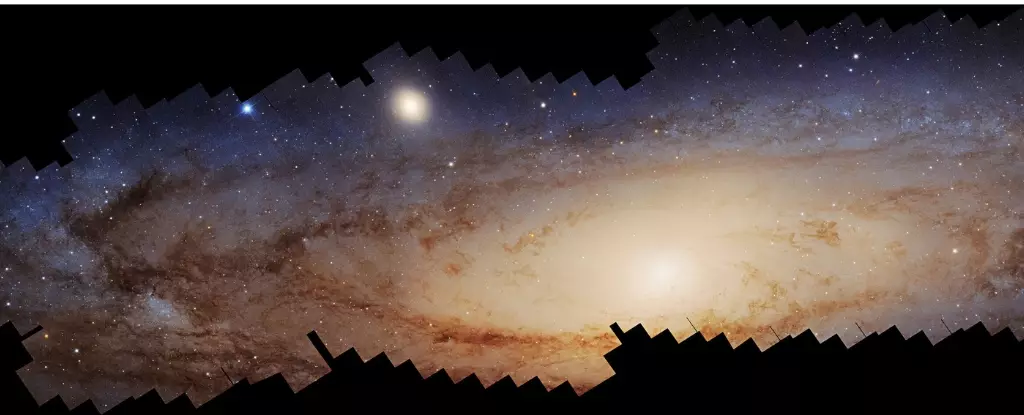The Andromeda Galaxy, officially designated as M31, stands as a remarkable phenomenon in our cosmic neighborhood. It holds the title of being the closest spiral galaxy to the Milky Way, providing a unique opportunity for astronomers and stargazers alike. This majestic galaxy is not a simple distant object; instead, it serves as a crucial point of study that could unlock the secrets of galactic evolution and our own place in the universe. With the ability to observe Andromeda with the naked eye under optimal conditions—albeit as a faint smudge—our understanding of its significance extends far beyond mere visibility.
NASA’s Hubble Space Telescope has dramatically advanced our knowledge of Andromeda, most notably through an impressive ten-year project that culminated in a stunning 2.5-gigapixel mosaic photograph of the galaxy. This meticulous collaboration involved over a thousand orbits of the telescope, painting an intricate picture of not just Andromeda but also revealing details about its stellar population. Unlike other galaxies, M31 allows astronomers to conduct detailed studies due to its proximity and similarity to our own Milky Way—a barred spiral galaxy. These studies often provide vital insights into unexplored regions of our galaxy, emphasizing the importance of Andromeda as a galactic analog.
Unveiling the Stars: A Closer Look
The mosaic created by Hubble resolves roughly 200 million individual stars, all exceeding the temperature of our Sun. This vast canvas, however, only scratches the surface, as many dimmer red dwarf stars remain undetected within the expanse of M31. The imaging is not just a collection of brilliant blue star clusters; it also encompasses background galaxies, star-forming regions, and dense dust lanes. Scientific efforts such as the Panchromatic Hubble Andromeda Treasury (PHAT) and its companion observation program, PHAST, have propelled our understanding of galactic dynamics. These initiatives have allowed scientists to contextualize their findings by comparing the galactic structures and behaviors observed in Andromeda to those within the Milky Way.
M31: More than Just Bright Stars
Andromeda is more than a mere celestial neighbor; it offers researchers a one-of-a-kind opportunity to analyze complex phenomena that affect galaxies during their lifecycles. One impressive aspect of the findings is that the southern disk of M31 presents a disturbed structure when scrutinized closely. This upheaval suggests a rich history of mergers and interactions that have shaped its current form, unlike its northern counterpart—a detail previously overlooked in earlier studies. These revelations suggest that studying the southern disk could lead to significant new insights about galactic formation and evolution.
M31’s fascinating history is hinted at through its interactions with neighboring galaxies. For instance, the presence of M32, a dwarf galaxy currently in orbit around Andromeda, raises questions about the merger events that have shaped the larger galaxy. Astronomers believe M32 may be a remnant of a more massive galaxy that was absorbed during Andromeda’s formative years. By observing tidal debris streams such as the Giant Southern Stream, researchers uncover vital evidence supporting these merger theories. The star metallicity in this stream, for example, contrasts against the averages found in M31’s disk and bulge, further pointing to a complex evolutionary narrative.
The Hubble’s observations play a vital role in reconstructing Andromeda’s history, allowing astronomers to formulate a detailed blueprint of its past events. Current studies suggest that Andromeda may be transitioning between a star-forming spiral and an elliptical galaxy predominantly composed of red giants. This transitional state, indicative of a galaxy in flux, holds numerous implications for our understanding of galactic evolution—not only for Andromeda but also for galaxies throughout the universe.
Future Exploration
Looking forward, the imminent launch of the Nancy Grace Roman Space Telescope promises to enhance our comprehension of Andromeda further. This advanced infrared telescope is expected to transform the study of M31 by capturing the equivalent of multiple high-resolution Hubble images in just a single exposure. Such capabilities will allow astronomers to delve into the intricacies of the Giant Southern Stream and better understand the galaxy’s merging history. As we continue to explore the mysteries of Andromeda, the insights gained will inevitably reflect back on our own Milky Way, illuminating the cosmic ballet that has unfolded over billions of years—an endless journey we still have much left to discover.


Leave a Reply